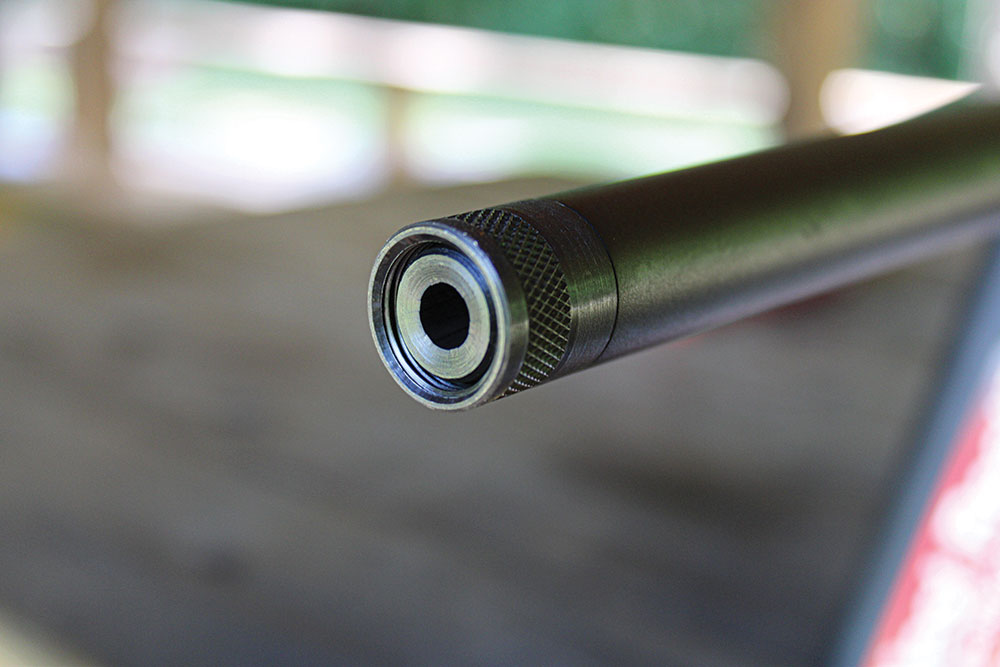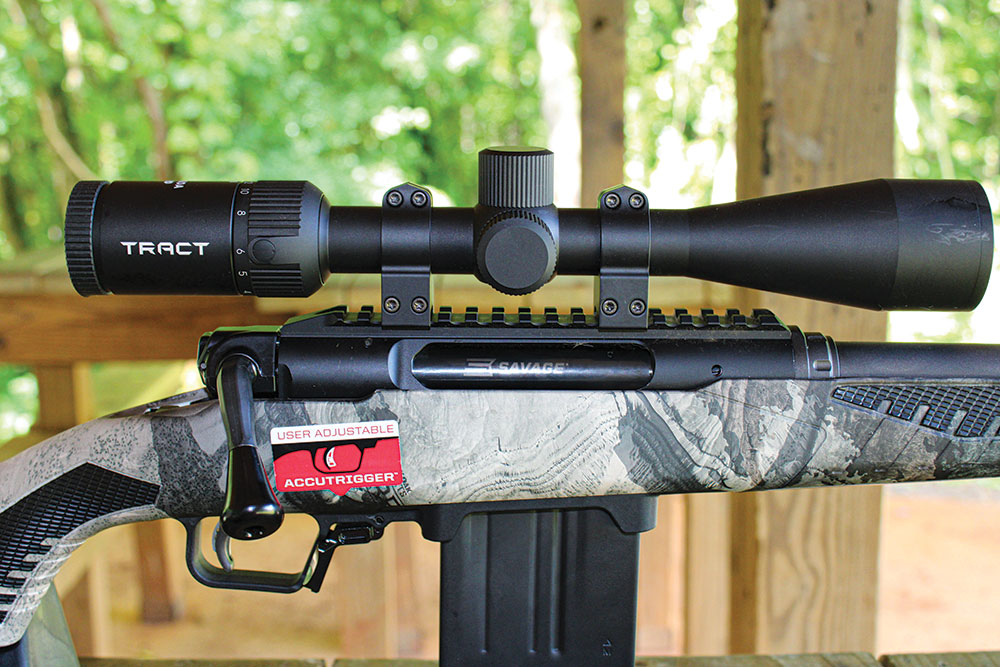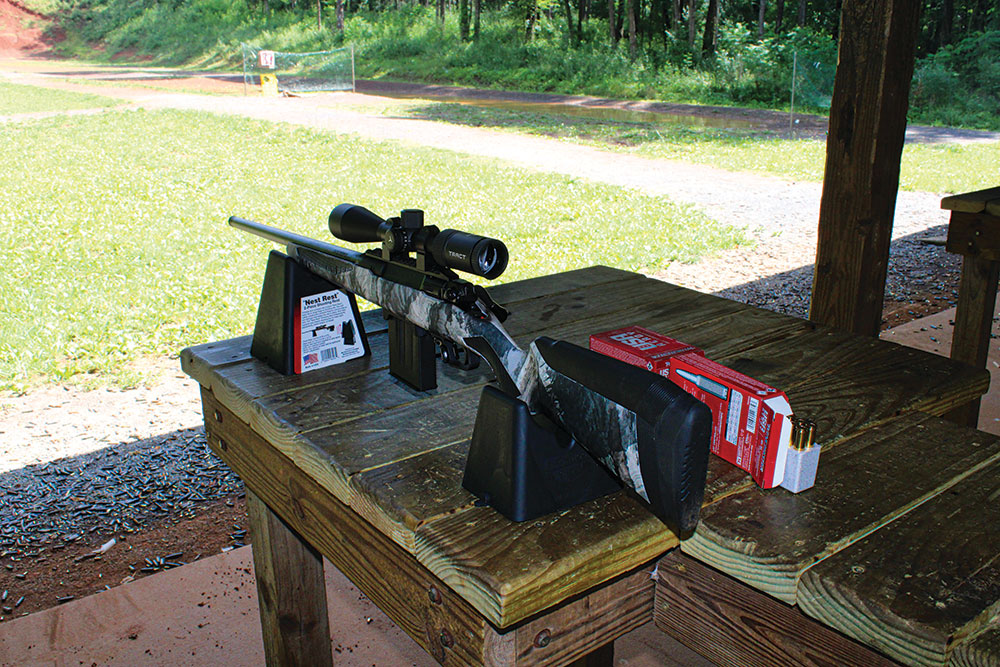Savage’s New Straight-Pull Bolt Action Allows for Faster Follow-Up Shots.
The bolt-action rifle comes from an amazing design that combines strength and accuracy. In addition, pretty much any caliber can be used in a bolt-action rifle—all the way up to a .50 BMG—making the bolt action the preferred rifle for long-range shooters and many hunters.
The only problem with bolt-action rifles is that they’re slow to cycle, requiring four separate motions to place a new round in the chamber: Lift up, pull back, push forward and push down. This doesn’t take long, especially for trained shooters, but these motions can take sights off target and reduce follow-up shot speed, regardless of a shooter’s skill.
However, Savage is trying to change this with a straight-pull bolt-action rifle called the Impulse.
Straight-Pulls Aren’t New
Straight-pull rifles have been popular in Europe for years, but these types of actions have never really gained popularity in the United States. The reasons for this have mostly been due to strength of action and accuracy. There have, however, been some examples used in the United States over the years, including one that was the official rifle of the Navy and Marines for a short period: the Lee Rifle Model of 1895 (M1895).
“Proper fit helps accuracy, and the AccuFit system provides adjustment for more than just those who are particularly tall or short; in fact, it allows proper fit for pretty much everyone.”

Straight-pull actions have had problems in the past, particularly with the more powerful loads preferred by American shooters. In addition, these rifles weren’t generally the most accurate—or at least they haven’t been in the past.

Savage has fixed both these problems with a hexlock locking mechanism. This system consists of six steel bearings in a ring around the bolt head. A plunger inside the bolt body presses the bearings out, locking them into the barrel extension, putting the rifle into battery.
Savage Reinvents the Straight-Pull
What’s truly interesting about this system is that the pressure pushing out on the bearings makes the action hold even tighter, increasing the strength to handle larger calibers. Now, releasing that pressure involves cycling the bolt, which, of course, doesn’t require the typical four-step process. To eject the spent case and insert a fresh cartridge, one simply has to pull the bolt handle toward the rear and then push it forward. Cycling this action is much faster than in standard bolt actions.
“Accuracy was on par for a high-quality 6.5 Creedmoor rifle … meaning that it was excellent.”

To create this speed and accuracy, Savage placed 13 patent-pending parts on the Impulse, showing that this company doesn’t believe that luck has anything to do with the success of its firearms. It also makes the Impulse a very revolutionary design, at least in theory. Of course, most shooters care more about features, function and accuracy. This, typically, is where Savage really shines.

Savage began the creation of the Impulse with an AccuStock chassis, which includes a barrel lock nut that allows for accurate headspacing, along with the use of lighter materials in the receiver. The company then button-rifled the barrels and added the AccuTrigger—one of the best user-adjustable factory triggers on the market.

All this goes together to create a rifle with sub-MOA possibilities in the right hands, particularly when the proper fit is ensured. For this, Savage included AccuFit. This basically means the Impulse comes with everything needed to adjust fit for both length of pull and cheek placement. Proper fit helps accuracy, and the AccuFit system provides adjustment for more than just those who are particularly tall or short; in fact, it allows proper fit for pretty much everyone.
Other features standard on the Impulse include an integral Picatinny rail for mounting optics, an ambidextrous, two-position safety and a threaded barrel for adding brakes or suppressors.

One truly interesting feature that comes on the Impulse, but wouldn’t normally be considered standard, is the reversible bolt handle. This means that the Impulse works for both left- and right-handed shooters and can be fairly easily swapped when needed. Shooters have five different positions for the bolt handle for each side, so it can be customized for shooters’ needs for speed and cycling comfort.

Because of all this, breaking down the Impulse for cleaning and routine maintenance is fairly simple. Shooters can disassemble the bolt assembly, the bolt head and the stock by consulting the manual Savage has included (luckily, those who regularly misplace paperwork can also find the manual online). Just always be sure to depress the cocked indicator/quick-release button to ensure the rifle is unloaded before performing any cleaning or maintenance.
The Impulse comes in three models—the Hog Hunter, Big Game and Predator—providing slightly different camouflage and caliber options and with some calibers crossing over to all three versions.
Savage Arms Impulse Predator
Specifications
- Chambering: 6.5 Creedmoor (tested), .22-250 Rem., .243 Win., .308 Win.
- Action: Straight-pull bolt-action rifle
- Receiver: Aluminum, black matte finish
- Stock: AccuStock, synthetic, Mossy Oak Terra Gila Camo, matte finish
- Overall length: 41.25 inches
- Barrel length: 20 inches
- Length of pull: 12.75–13.75 inches
- Weight: 8.75 pounds
- Magazine: 10-round detachable
MSRP: $1,379
SavageArms.com
Range Results
Velocity (fps) Accuracy (inches) Average Best
Winchester USA Ready 125-grain Open Tip 2,709 0.97 0.8
Federal American Eagle 140-grain Open Tip Match 2,568 1.16 1.0
Notes: Accuracy is based on five groups of three shots each. Velocity is based on 10 shots fired through a Caldwell Ballistic Precision Chronograph at 10 feet. The temperature measured 81 degrees (F) with 49 percent humidity.
Testing the Predator
For testing, I received a Predator model chambered in 6.5 Creedmoor. In the hands, the Impulse feels like any standard bolt-action rifle with a synthetic stock. It’s a touch heavier than some other rifles, weighing in at more than 8 pounds without a scope. However, it was hard to tell in the moment, because I was staring at a newly designed gun that very few people had even seen.
“The Impulse comes in three models—the Hog Hunter, Big Game and Predator—providing slightly different camouflage and caliber options and with some calibers crossing over to all three versions.”

The stock felt nice, as if it were designed for being used—which, because it’s camouflaged synthetic, is what Savage planned for this gun. Overall, the entire rifle had pretty smooth lines, a slick, matte barrel and a great feel. My first impression was that Savage might really be on to something if the gun performed the way it looked and felt.

I really liked the fact that the barrel was threaded to accept a suppressor (even though it’s pretty much standard on rifles now). While the Hearing Protection Act keeps being blocked in Congress, many in the shooting industry are still hopeful that it will eventually pass and become law, making cans much easier to obtain.
After a quick look at the manual, I put the bolt into the gun and started working the action. At first, it seemed to want to hang, just for a heartbeat, when pulled to the rear. Then, I figured it was because the gun was brand-new and needed to break in just a touch before it would become smooth in the pull.

So, I went ahead and attached a TRACT Optics 3-12×42 scope before heading to the range for sighting and to get a better understanding of what this rifle could do in the real world.
However, even after working the action numerous times and firing a couple of boxes of ammunition through it, the action still hung up occasionally for the slightest moment. It didn’t happen with every pull, but it was noticeable. I absolutely couldn’t figure out why until I sat down at the range bench for accuracy testing.

I slowly cycled the action and realized I was grabbing the bolt high, as I would with a standard bolt action; this was clearly interfering with the intended motion. To properly cycle the action, I needed to either pull straight back right at the knob on the end of the bolt or give the entire bolt a quick twist back before pulling back on the action.
Once I figured out the motion, cycling a new round was extremely smooth and much faster than the four-step motion of a standard bolt action. From that point on, the action had zero hang-ups during firing—which obviously made testing go much easier.
Accuracy
To test accuracy, I fired five three-round groups twice from a bench with two types of 6.5 Creedmoor ammunition—Winchester USA Ready 125-grain Open Tip and Federal American Eagle 140-grain Open Tip Match—for a total of 60 rounds.

In between the groups, I let the rifle cool down for five minutes, with 10 minutes of cooling time after 15 shots. Accuracy was on par for a high-quality 6.5 Creedmoor rifle … meaning that it was excellent. Both loads consistently put three rounds within 1 inch, with Winchester beating out Federal by only a slim margin. The Winchester load averaged just under an inch, while the Federal load came in at just over an inch. Both loads showed the potential for accuracy of 6.5 Creedmoor and the Savage Impulse.

Because of the different bullet weights, the chronograph results weren’t surprising. The Winchester loads average 150 fps (feet per second) faster than the Federal loads. This didn’t affect accuracy, but the heavier Federal loads hit significantly lower, especially because I sighted the rifle with Winchester. Both loads were fairly consistent in fps and would provide MOA accuracy from the Impulse.
Follow-Up Shot Potential
After determining the accuracy, I ran a few drills to learn the Impulse’s follow-up shot potential. While I don’t have a shot timer, it was obvious that cycling the action was much quicker than on a standard bolt action. One major reason was that I didn’t have to take the rifle off my shoulder to cycle the action. Also, it was much quicker to just pull and push the action to reload. I was able to fire three, four, maybe even five shots in about the same amount of time I could send two downrange from a bolt action.

Caveats
Whether I was standing, kneeling or prone, cycling the Impulse was fast and smooth and provided quick follow-up shots on multiple targets.
The only problem I faced throughout testing was that after attaching a scope, the rifle was fairly heavy. This isn’t noticeable if you use a rest or possibly a bipod. However, when firing from a standing position without a rest, the barrel wavers, and I would definitely want a sling if I were packing into more-remote areas.

Another issue I found is that you have to be careful when inserting the bolt into the rifle. There’s a groove on the bolt that needs to line up with the bolt release before sliding it into the gun. Also, the bolt head has a lever on the bolt to remove it for cleaning, meaning that it needs to be securely attached before putting the gun back together.
While these issues are fairly easy to remember, they do mean the gun isn’t what I’d call “idiot proof.” Of course, few guns truly are; it’s been my experience that there’s always a way to mess one up.
A New Old Design
The Savage Impulse is a new design based on an old design. Savage, of course, improved on an idea that’s been popular in Europe for quite a while. The question is whether American shooters and hunters will accept the design.
There are a lot of differences between American and European shooters, particularly when it comes to caliber choices and capacity. However, speed and accuracy transcend continents. American shooters are going to like the Impulse’s fast follow-up shot speed and available calibers. And, because some of the more popular calibers (such as .308 Winchester and 6.5 Creedmoor) cross over models, hunters have a chance to choose their preferred model and caliber and use it for a variety of species.

Just because Savage named this model the Impulse “Predator” doesn’t mean it can’t be used for hogs or big game—and vice versa with the other models. Those who prefer the accuracy of bolt actions but would like to speed up follow-up shots should consider the Impulse.
Savage has certainly created a nice way of combining speed and accuracy.
The author spent quite a few hours determining the accuracy of the Impulse and chronographing the speed of the ammunition. (Photo: Paul Rackley)
TRACT Optics
Accuracy in a rifle is great … and it’s important if you want to actually hit anything at a distance. However, you must also be able to see what you’re shooting at—which means you’ll need a good scope.
While there are a lot of good optics brands on the market, I decided to go with TRACT Optics for my review of the Impulse, and I didn’t regret that decision.
Like all high-end riflescopes, the TRACT was extremely clear, even in low light, due to its multicoated lens, and its side-focus parallax made fine-tuning the clarity very simple. Other nice features include a quick-focus eyepiece, glass-etched BDC reticle and argon gas purged for water- and fog-proofing.
All TRACT scopes come with a full lifetime warranty, along with a customer service department that absolutely shines! (In fact, TRACT fixed a problem for a friend of mine faster than he thought was possible.)
Of course, capability is the most important feature, and the TRACT aced its shooting-the-square test. After sighting it in, moving the bullet impact to one side by an inch required four ¼-inch clicks. To take it an inch past the original point of aim in the other direction needed exactly eight clicks.
Regardless of the direction I wanted to move the scope, adjustment was exact; there’s no better testament to the quality of a scope.
TRACT Optics
TractOptics.com
A version of this article first appeared in the October 2021 issue of American Outdoor Guide Boundless.


